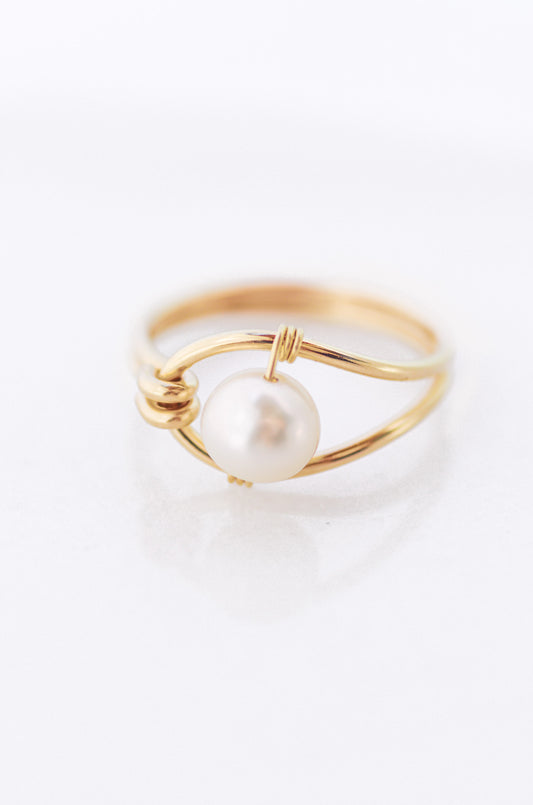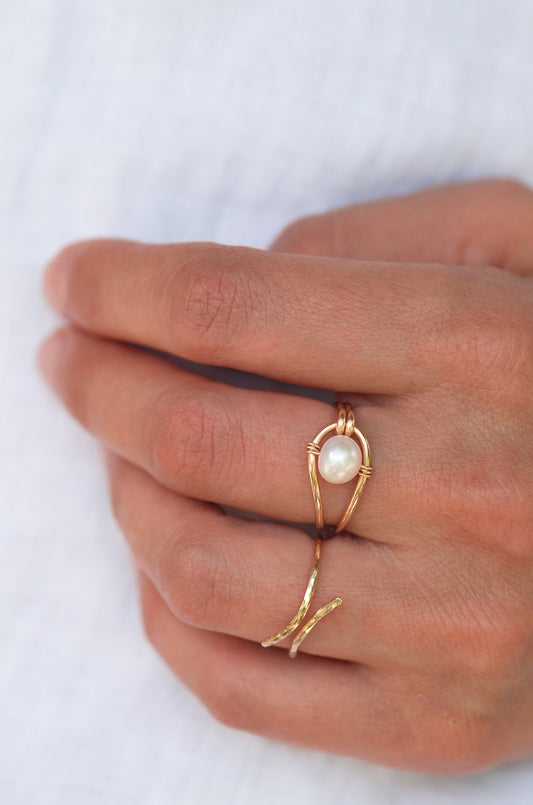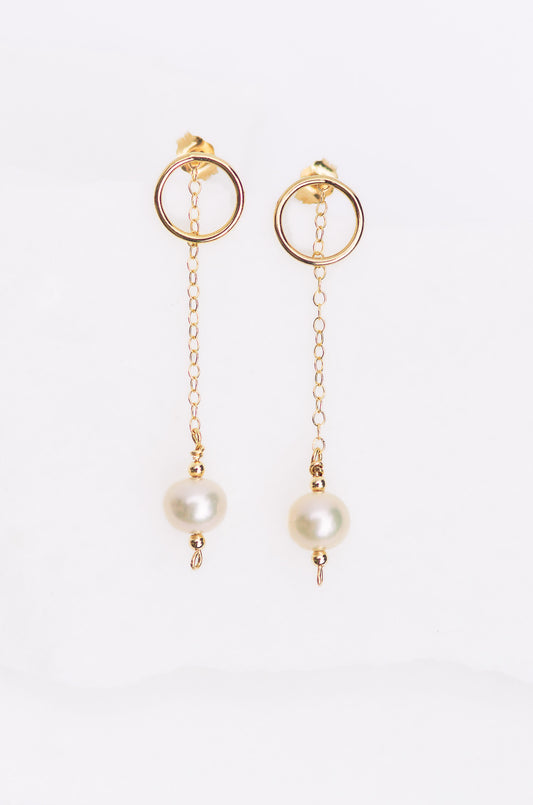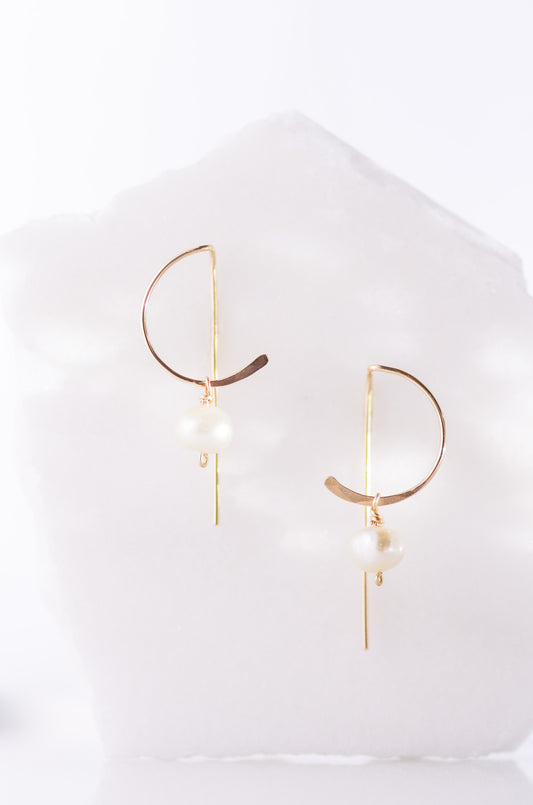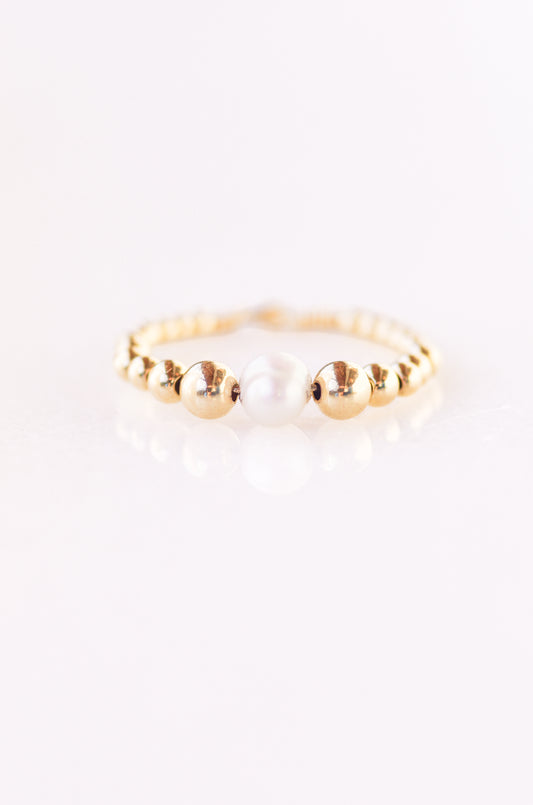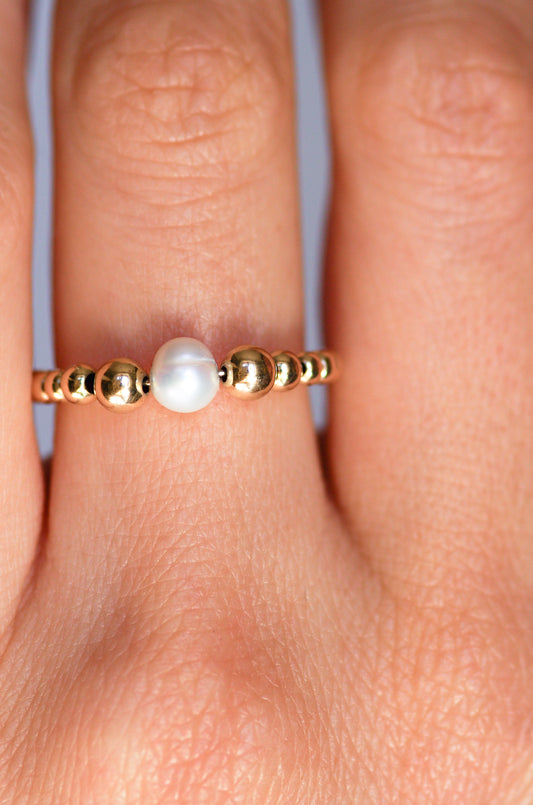
Gold-Filled vs. Gold-Plated: How to Tell the Difference
Teilen
When deciding between gold-filled and gold-plated jewelry, the key differences lie in gold content, durability, and price. Gold-filled jewelry (the type we create at Rays&Riches) contains at least 5% gold by weight, making it 100 times richer in gold than gold-plated pieces, which have less than 0.05%. This thicker gold layer gives gold-filled items a longer lifespan and makes them more resistant to tarnishing and flaking. Gold-plated jewelry, on the other hand, is less durable but more affordable.
Quick Overview:
- Gold-Filled: Contains more gold (5%), lasts longer, hypoallergenic, higher price.
- Gold-Plated: Minimal gold content (<0.05%), wears out faster, may irritate skin, lower price.
Quick Comparison Table:
| Feature | Gold-Filled | Gold-Plated |
|---|---|---|
| Gold Content | At least 5% by weight | Less than 0.05% by weight |
| Durability | Long-lasting | Prone to wear and flaking |
| Price (€) | medium - high | very low - high |
| Skin Sensitivity | Generally safe | May cause irritation |
| Production Method | Heat/pressure bonding | Electricity & Chemicals |
If you want jewelry that lasts and is better for daily wear, gold-filled is the better choice. If you're after trendy, budget-friendly designs for occasional use, gold-plated might suit your needs.
How to Tell Gold-Filled from Gold-Plated
Figuring out whether a piece of jewellery is gold-filled (the type of material we use at Rays&Riches) or gold-plated can sometimes feel tricky. But with a few key observations, you can usually tell the difference - whether you're inspecting a new purchase or a well-loved piece from your collection.
Checking New Jewellery
One of the first clues is the price. Gold-filled jewellery generally costs more because it contains about 100 times more gold than gold-plated pieces. But lots of gold-plated jewelry is overpriced, so price isn’t always a clear sign.
The colour can also give you a hint: gold-filled items often have a warmer 14K tone, while gold-plated jewellery tends to lean toward the more yellow shades of 18K gold. Keep in mind that the exact hue may vary slightly, but the gold content in gold-filled jewellery is consistent.
Take a close look at the construction. Gold-filled jewellery is often made by assembling individual components such as wires, chains, or beads.
Gold-plated jewelry, on the other hand, often starts as a solid piece made by casting — which means molten metal is poured into a mold to create a continuous, detailed shape. After casting, the entire piece is coated with a thin layer of gold through electroplating. So if you see jewelry with smooth, continuous shapes it is most likely not made from gold-filled materials.
The price disparity reflects these differences. Gold-filled jewellery, with its higher gold content and more intricate manufacturing process, typically costs between €40 and €200 or more. Gold-plated pieces, meanwhile, are more budget-friendly. But lots of gold-plated jewelry is overpriced, so price isn’t always a clear sign.
Pay attention to the details. Rough seams and edges are often signs of cheap, mass-produced gold plated jewelry. Over time, as the jewellery is worn, more differences between the two types become noticeable.
Examining Worn Jewellery
Wear and tear can reveal a lot. People with sensitive skin might experience irritation from gold-plated jewellery because of the base metal underneath the thin gold layer.
Gold-plated pieces often show their wear through flaking or tarnishing, as the thin layer of gold begins to wear off, revealing the base metal underneath. Even vermeil - a higher-quality type of gold-plated jewellery - can lose its gold layer quickly, though it may rub off rather than flake.
Gold-filled jewellery, on the other hand, holds up much better. While it can still get scratched like any other piece, the gold layer is heat- and pressure-bonded to the base metal, ensuring it stays intact. This process helps gold-filled jewellery resist flaking and tarnishing, even with regular use. Designs made from thicker components are more durable than delicate ones.
Read on to understand the main differences between Gold-Filled (the type of material we use at Rays&Riches) and Gold-Plated.
What is Gold-Filled Jewelry?
Gold-filled jewelry strikes a middle ground between gold-plated and solid gold pieces. Unlike gold-plated items, gold-filled jewelry features a thick layer of gold mechanically bonded to a brass core. This technique not only gives it a luxurious appearance but also ensures it lasts much longer.
By law, the gold layer in gold-filled items must make up at least 5% of the total weight, which means it contains about 100 times more gold than standard gold-plated jewelry.
Typically, the outer layer of gold-filled jewelry is made from 14-karat gold. This choice offers a perfect mix of durability and elegance. The 14K gold layer has a slightly warmer tone compared to higher karat gold, giving it a refined look that complements a wide range of skin tones.
How Gold-Filled Jewelry is Made
Creating gold-filled jewelry involves a mechanical bonding process that doesn’t rely on chemicals. Sheets or wires of 14K gold are layered over a base metal - usually brass - and then fused together using heat and pressure. This process forms a strong molecular bond, making the gold layer an integral part of the piece rather than just a surface coating.
Brass is often chosen as the base metal due to its compatibility with gold and its strength. Authentic gold-filled pieces are sometimes stamped with marks like "1/20 14K GF" or "14KGF 1/20", which indicate the gold content and karat weight.
Durability and Skin Safety
One of the standout features of gold-filled jewelry is its durability. Unlike gold-plated items, which can lose their coating within months or even weeks, the thick gold layer on gold-filled pieces can maintain its shine and integrity for years. This makes them perfect for everyday wear.
Additionally, gold-filled jewelry is a safer option for those with metal allergies. The thicker gold layer significantly reduces the risk of irritation or allergic reactions, and it resists flaking or peeling over time, ensuring the jewelry remains both beautiful and comfortable to wear.
Environmental Benefits
The production of gold-filled jewelry is also kinder to the environment compared to traditional gold-plating methods. The process uses heat and pressure, avoiding the need for chemical baths used for electroplating, which result in toxic waste. On top of that, many manufacturers of gold filled metals are now adopting eco-friendly practices, such as using recycled gold and ethically sourced materials. These efforts not only reduce environmental impact but also contribute to creating longer-lasting, sustainable jewelry.
What is Gold-Plated Jewelry?
Gold-plated jewelry is a popular choice for those who want very affordable jewelry. It features a thin layer of gold applied over a base metal, giving it the appearance of solid gold but at a fraction of the price. However, because the gold layer is so thin, these pieces typically lack the durability and lifespan of jewelry with a thicker gold layer.
How Gold-Plated Jewelry is Made
Gold-plated jewelry is created through electroplating, a process that uses an electric current to deposit a very thin layer of gold onto a base metal like brass, copper, or nickel. This involves chemical baths containing hazardous substances, which inevitably have negative impacts on the environment and workers’ health. These chemicals must be produced, used, and disposed of—often in countries where regulations are minimal or not enforced—leading to pollution and unsafe working conditions. Because the gold layer is so thin, the base metal quality strongly affects how fast tarnish and corrosion occurs.
Wear and Skin Reactions
With frequent use, the thin gold layer can wear away, exposing the underlying base metal. This not only affects the appearance but may also cause skin irritation or allergic reactions, especially for individuals sensitive to cheap metals.
Despite these drawbacks, gold-plated jewelry remains appealing due to its affordability and the wide range of designs it offers.
Affordable and Suitable for Mass Production
The low cost of gold-plated jewelry makes it ideal for mass production, enabling manufacturers to release new styles in quick succession, much like fast fashion.
Main Differences Between Gold-Filled and Gold-Plated
When it comes to jewellery, the differences between gold-filled and gold-plated pieces boil down to three main factors: gold content, bonding methods, and durability. These distinctions directly influence both the quality and the value of each type.
Gold-filled jewellery (the type of material we use at Rays&Riches), contains a minimum of 5% gold by weight, while gold-plated pieces have less than 0.05% gold. To put it into perspective, gold-filled jewellery holds about 100 times more gold than standard gold-plated items.
The manufacturing processes are another key difference. Gold-filled jewellery is created by permanently bonding a thick layer of gold to a base metal using heat and pressure. In contrast, gold-plated jewellery is made through electroplating, a chemical method that applies a very thin gold layer. This thin coating on gold-plated items is more prone to wearing off over time.
Durability is also a major factor. Gold-filled jewellery (the type of material we use at Rays&Riches), maintains its colour and finish for years, resisting tarnish and flaking. On the other hand, gold-plated pieces tend to flake or tarnish more quickly. Additionally, the thicker gold layer in gold-filled jewellery reduces the risk of skin irritation, making it a better choice for sensitive skin. Gold-plated jewellery, however, can sometimes cause allergic reactions.
Here’s a quick comparison to make these differences even clearer:
Side-by-Side Comparison
| Feature | Gold-Filled | Gold-Plated |
|---|---|---|
| Gold Content | At least 5% by weight | Less than 0.05% by weight |
| Manufacturing Process | Heat/pressure bonding | Electroplating using chemicals |
| Durability | Long-lasting; resists tarnish and flaking | Prone to wear, flaking, and tarnish |
| Price Range (€) | Medium | Low |
| Skin Sensitivity | Generally hypoallergenic | May cause irritation |
| Common Designs | Assembled elements (e.g., wires, beads) | Cast designs and a vast variety of shapes |
| Markings | Often stamped (e.g., 1/20 14K GF) | No standardised markings |
While gold-filled jewellery may have a higher upfront cost, its durability often makes it a more economical choice in the long run.
Lastly, there’s the question of environmental impact. Gold-filled jewellery is often considered a more sustainable option, even more so when manufacturers use ethically sourced or recycled gold since it avoids chemical-heavy processes. This makes it a thoughtful choice for those prioritising sustainability in their purchases.
Understanding these distinctions will help you choose the right jewellery to match your needs, preferences, and budget.
sbb-itb-2024ddf
Rays & Riches: Gold-Fill Quality and Ethics
Rays & Riches stands out by committing to ethical practices and exceptional craftsmanship, focusing exclusively on high-quality gold-fill. This dedication ensures their jewellery not only looks stunning but also aligns with responsible production values.
Materials and Craftsmanship
Rays & Riches uses gold-fill, a material that contains 100 times more gold compared to gold-plated alternatives. This process guarantees a more durable and luxurious finish that lasts.
Instead of relying on chemicals, heat and pressure is being used to bond gold to the base metal. This technique results in a thicker, more resilient layer that resists tarnishing, flaking, and skin irritation. The gold used for their jewerly is ethically sourced and recycled, while repurposed pearls and gemstones help reduce the demand for newly mined materials. By avoiding gold plating, they minimize waste and offer better quality.
Design Philosophy and Core Values
Inspired by natural elements, including the golden ratio, Rays & Riches creates jewellery that feels balanced and meaningful. Their collection includes earrings, rings, ear cuffs, and bracelets, blending Italian elegance with a modern twist. Whether you prefer minimalist designs or bold, playful styles, there’s something for everyone. Prices range from €8,00 for ear cuffs to €150,00 for earrings, reflecting the meticulous craftsmanship behind each piece.
Rays & Riches also prioritizes small-scale, local production, ensuring a personal touch in every order. With transparent processes and carbon-neutral shipping, they’ve built a reputation for trustworthiness. Every piece embodies these values, empowering you to choose jewellery that’s as ethical as it is beautiful.
Making the Right Choice for Your Jewelry
Deciding between gold-filled and gold-plated jewelry often comes down to factors like budget, daily wear, skin sensitivity, and how the pieces are made.
When it comes to durability, gold-filled jewelry stands out. Its thick layer of gold not only keeps its shine for years but also resists tarnish far better than gold-plated items, which can start showing signs of wear in just a few weeks.
If you have sensitive skin, gold-filled pieces are a smart option. The thicker gold layer acts as a barrier, reducing exposure to base metals that you might be allergic to.
How the jewelry is made also matters. Gold-filled items are created using a heat and pressure process that avoids chemicals, making them a cleaner choice compared to the chemical-heavy production of gold-plated jewelry. While gold-filled jewelry may cost 2–10 times more than gold-plated alternatives, its durability often makes it a better investment over time.
Your wearing habits should guide your decision. If you’re looking for something to wear daily or a keepsake that will last for years, gold-filled jewelry is the way to go. On the other hand, if you’re after trendy or occasional pieces, gold-plated jewelry might be more practical.
Italian shoppers, known for their appreciation of elegance and quality, often favor jewelry that combines durability, ethical production, and sophisticated design. Transparency in sourcing and expert craftsmanship align perfectly with these preferences, making gold-filled jewelry an attractive choice for many.
Ultimately, your decision should reflect your lifestyle, budget, and the importance you place on long-lasting quality. By weighing these factors, you can choose jewelry that truly matches your needs and values.
FAQs
How can I tell if a piece of jewellery is gold-filled or gold-plated when shopping online?
Distinguishing gold-filled from gold-plated jewellery when shopping online can feel challenging, but there are some telltale signs to guide you. Gold-filled jewellery often carries a stamp like 1/20 14k GF or 14kGF. This indicates that at least 5% of the item's total weight is gold. The gold layer is bonded to a base metal through heat and pressure, making it thicker, more durable, and resistant to tarnishing compared to gold-plated options.
Gold-plated jewellery, in contrast, features a much thinner layer of gold, which wears away faster, often exposing the base metal underneath. Over time, this can lead to flaking or discolouration, especially with frequent use.
Another clue lies in the design and construction. Gold-filled pieces are often crafted from individual components like wires, beads, or chains. If a piece appears as one seamless, cast component, it’s likely not gold-filled. Lastly, while price can sometimes hint at the difference - gold-filled jewellery is generally more expensive due to its gold content - price alone isn’t always a reliable indicator.
What makes gold-filled jewelry more environmentally friendly than gold-plated?
Gold-filled jewelry stands out as a more environmentally conscious option due to its chemical-free bonding process. Instead of relying on harsh chemicals, the gold layer is permanently fused to the base metal using heat and pressure. This approach significantly cuts down on chemical waste and reduces pollution compared to the methods used for producing gold-plated jewelry.
What’s more, Rays & Riches gold-filled pieces use ethically sourced or recycled gold, which helps lessen the environmental toll of mining. This practice supports the responsible use of resources while lowering the overall impact on the planet. Opting for gold-filled jewelry is a thoughtful way to prioritize both durability and environmental responsibility.
Is gold-filled jewellery better for sensitive skin than gold-plated jewellery?
Yes, gold-filled jewelry is a much better option for those with sensitive skin compared to gold-plated pieces. Why? Gold-filled jewelry contains 100 times more gold than its gold-plated counterpart. Plus, it’s made using a heat and pressure process that bonds the gold to the base metal without relying on chemicals. This process makes it gentler on the skin and less likely to cause irritation.
On the other hand, gold-plated jewelry only has a very thin layer of gold, which can wear off quickly, exposing the base metal underneath. For people with sensitive skin, this can lead to allergic reactions or discomfort. Gold-filled pieces, however, are more durable and crafted to retain their quality over time, making them a safer and longer-lasting choice for sensitive skin.
Related posts
- Best Jewelry for Sensitive Skin: Top Options
- 7 Ways to Care for Gold-Filled Jewelry at Home
- The Role of Jewelry in Slow Living and Growth

